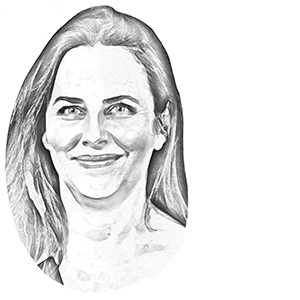Our brains are our most precious asset, the literal font of innovation. Viewing our collective brains as an invaluable resource should be a national priority. They are the crucial building blocks for a productive society.
Enter the concept of brain capital, which encompasses the cumulative brain health and brain skills of a society. We need to invest in brain capital to drive Australia’s growth and prosperity.

In the age of AI, it’s important to educate our brains to outsmart the downsides of algorithms. Investing in our creative intelligence and digital literacy could lead to more fulfilling lives and ensure we have the skills for whatever the future workplace demands of us. Brain capital also underpins the social prosperity found in volunteering, caring work and community participation, and helps build individual and community resilience.
Dividends of collective brain power
The brain capital movement is a framework to guide the transition from an industrial economy to a brain economy. The Brain Capital Alliance (Alliance) was formed following the success of the OECD neuroscience-inspired policy initiative and unites world-class contributors to explore how to best build brain capital at a societal scale. The multinational steering committee includes the Minderoo Foundation’s Thrive By Five director and former South Australian premier Jay Weatherill and the USYD Brain and Mind Centre’s Mental Health Initiative’s co-director Associate Professor Jo-An Occhipinti. It is led by Rice University’s Baker Institute for Public Policy Fellow and former Australian Fulbright Scholar, Professor Harris A. Eyre.
In 2021, the Alliance launched the global brain capital dashboard to quantify and track brain capital and inspire policymakers. The interactive dashboard has been developed by the Euro-Mediterranean Economists Association and brings together the drivers that promote or impede the accumulation of brain capital. The European Brain Council will meet in September 2024 at the 79th United Nations general assembly in New York to emphasise the urgency of prioritising brain health at the global level.
Mental wealth is national prosperity
Brain capital underpins economic and social production. Professor Occhipinti was the lead author of Estimating the mental wealth of nations: valuing social production and investment, a 2023 paper published in Nature Mental Health. The paper canvasses the global movement questioning whether gross domestic product (GDP) is an appropriate indicator of national prosperity when it fails to include social production, which is fuelled by brain capital. The authors argue that GDP should be augmented to include social productions known as mental wealth.
The business case is already there. In Australia, a 2021 BeyondBlue/PwC Report found that untreated mental health conditions cost our workplaces $10.9 billion per year including $4.7 billion in absenteeism and $6.1 billion in presenteeism.
Australia can join the global movement in prioritising brain health and skills by leveraging our comparative advantage in neuroscience and neurotech. To do this, we need a coordinated approach that starts with blue-sky research to inform entrepreneurship and innovation to address societal challenges and create new industries.
The Australian Brain Alliance, formed in 2016 and supported by the Australian Academy of Science, has advocated for an Australian brain initiative. They asked for $500 million over five years to facilitate linkages between discovery and industry to “crack the brain’s code”, develop treatments and establish an Australian neurotech industry. They are still waiting for that funding.
Venture capital flowing into mental health tech has increased, nearing US$1 billion in 2020. The Davos Alzheimer’s Collaborative initiated a novel global public-private collaboration and the advent of health brain bonds to raise US$10 billion through the healthy brains global initiative.
Other recent government initiatives include the UN’s workplace mental health and wellbeing strategy, the European mental health initiative (with backing of US$1.3 billion), and the brain health plans of Switzerland and Finland. The Australian government’s Measuring what Matters framework is another. It has five themes to track progress on national wellbeing: healthy, secure, sustainable, cohesive and prosperous.
Such governmental boosts can leverage patient capital with longer timeframes. For example, the Alzheimer’s Disease Discovery Foundation was established in 1998. The venture philanthropy fund has since provided US$100 million for more than 550 Alzheimer’s drug discovery programs and clinical trials in 18 countries. Today, it can boast that 20 per cent of all treatments for Alzheimer’s in clinical trials have received the foundation’s support.
By making brain capital a central focus, we will measure what matters. What are we waiting for? Our brains are the most valuable resources we each have! Prioritising investment to strengthen, support, and protect them is a no-brainer.
Rachel Slattery is the director of Silver Futures. Silver Futures aims to help people rethink how they approach the second half of their lives to ensure a longer, healthier, contributing future. Rachel has also guided and nourished communities of curious minds in Australia about frontier tech and better ways of working for over 20 years with her team at Slatterys. Slatterys was the force behind some of Australia’s leading conferences, including the Agile Australia Conference established in 2009 and Tech23 – celebrating Australian deep tech startups. Slatterys managed Tech23 for 14 years before handing over to deep tech incubator Cicada Innovations.
This article is part of The Industry Papers publication by InnovationAus.com. Order your hard copy here. 36 Papers, 48 Authors, 65,000 words, 72 page tabloid newspaper + 32 page insert magazine.
The Industry Papers is a big undertaking and would not be possible without the assistance of our valued sponsors. InnovationAus.com would like to thank Geoscape Australia, The University of Sydney Faculty of Science, the Semiconductor Sector Service Bureau (S3B), AirTrunk, InnoFocus, ANDHealth, QIMR Berghofer, Advance Queensland and the Queensland Government.
Do you know more? Contact James Riley via Email.

